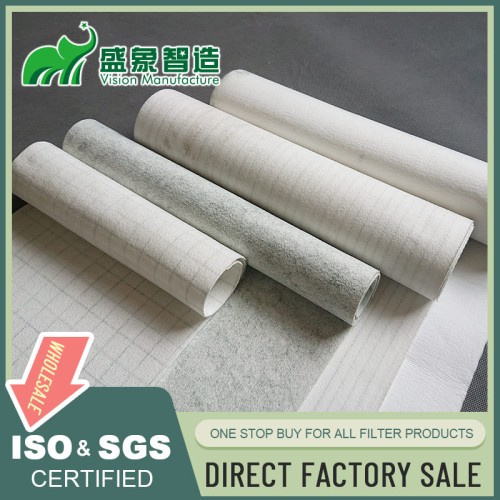
How Do Air Filter Cloths Enhance Air Quality in Industrial and Commercial Environments?
I. Introduction
In today's industrial and commercial environments, maintaining clean air is not just a health priority but also a critical operational requirement. Air filter cloth plays a pivotal role in achieving this by effectively removing contaminants from the air, thus enhancing air quality and contributing to energy efficiency. This article explores the technology behind air filter cloth, its importance, and its impact on various settings.
II. Types of Air Filter Cloth
- Non-woven Filter Media: Typically used for its versatility and efficiency in capturing dust particles.
- Woven Filter Fabrics: Known for their strength and durability, making them suitable for reusable applications.
- Membrane Filter Cloths: Provide high precision filtration, often used in critical applications.
- Electrostatically Charged Media: Enhances dust capture capabilities by attracting particles through an electrostatic charge.
III. Materials Used in Air Filter Cloth
- Synthetic Fibers (Polyester, Polypropylene): Popular for their resistance to moisture and chemicals.
- Glass Fibers: Offer high temperature resistance and rigidity.
- Activated Carbon-impregnated Cloths: Used for removing odors and gaseous pollutants through adsorption.
- Nanofiber-enhanced Materials: Provide superior filtration efficiency for sub-micron particles.
IV. Performance Classifications
- MERV Ratings Explained: Measures the filter's ability to capture larger particles between 0.3 and 10 microns.
- HEPA and ULPA Filtration Standards: High-efficiency standards capturing at least 99.97% of particles as small as 0.3 microns.
- EN 779 and ISO 16890 Standards: European and international standards that classify air filters based on their efficiency at capturing particulate matter.
V. Applications Across Sectors
- HVAC Systems in Commercial Buildings: Essential for maintaining indoor air quality and comfort.
- Industrial Air Purification: Used in manufacturing facilities to protect equipment and ensure product quality.
- Cleanroom Environments: Critical in pharmaceutical and electronics manufacturing for contaminant control.
- Automotive Air Filtration: Ensures clean air within vehicle cabins and protects engine components.
- Respiratory Protection Equipment: Provides filtration for personal protective equipment.
VI. Key Performance Characteristics
- Particle Capture Efficiency: The effectiveness of a filter in trapping airborne particles.
- Pressure Drop and Airflow Resistance: Impacts the energy consumption of air handling systems.
- Dust Holding Capacity: Determines how much dust a filter can hold before it needs replacing.
- Antimicrobial Properties (where applicable): Filters designed to inhibit the growth of bacteria and mold.
VII. Design Considerations
- Pleating Patterns and Depth: Affects the surface area and can enhance the filter's capacity and efficiency.
- Surface Treatments and Finishes: Can improve dust release and moisture resistance.
- Backing and Support Materials: Provide structural integrity to the filter.
- Frame and Gasket Integration: Ensures airtight seals and easy installation in filter housings.
VIII. Installation and Maintenance
- Proper Handling and Installation Techniques: Crucial for maintaining filter effectiveness and longevity.
- Monitoring Filter Performance: Regular checks to ensure optimal operation.
- Replacement Schedules and Indicators: Guidelines for when filters should be changed to maintain air quality.
- Disposal and Recycling Considerations: Addresses environmental concerns associated with filter disposal.
IX. Energy Efficiency and Cost Analysis
- Impact on HVAC System Efficiency: High-efficiency filters can reduce energy consumption by minimizing pressure drops.
- Initial Costs vs. Long-term Savings: Evaluating the upfront costs against the operational savings provided by durable, high-efficiency filters.
- Life-cycle Cost Analysis: Comprehensive assessment of the total cost of ownership of air filter cloths.
X. Environmental and Health Benefits
- Improved Indoor Air Quality: Directly impacts the health and well-being of building occupants.
- Reduction of Airborne Pollutants and Allergens: Helps in creating healthier environments.
- Energy Savings Through Efficient Filtration: Lower energy consumption contributes to environmental sustainability.
XI. Innovations and Future Trends
- Smart Filters with IoT Integration: Future filters could provide real-time data on air quality and filter status.
- Advancements in Nanofiber Technology: Enhance filtration capabilities, allowing for even finer particle capture with less resistance.
- Sustainable and Biodegradable Filter Materials: Development of eco-friendly materials that reduce environmental impact without compromising filtration efficiency.
XII. Case Studies and Success Stories
- Enhanced Air Quality in Commercial Buildings: Demonstrations of how advanced air filter cloths have significantly improved the indoor air quality in large office buildings, reducing sick building syndrome and increasing occupant productivity.
- Industrial Applications: Examples from manufacturing plants where upgraded air filter cloths have led to better air quality, protecting sensitive machinery and reducing maintenance costs.
- Innovative Uses in Automotive Industry: Case studies showing how specialized air filter cloths have improved air filtration in automotive production, leading to longer engine life and better cabin air quality.
XIII. Conclusion
Air filter cloths are indispensable in maintaining high air quality standards in both industrial and commercial settings. As the demand for cleaner air continues to grow, the development of advanced filtration materials and technologies is critical. Staying informed about the latest trends and innovations in air filter technology is essential for any business looking to improve their air filtration systems and ensure compliance with health and environmental regulations. The future of air filtration looks promising with the integration of smart technologies and sustainable materials, setting new standards for efficiency and environmental responsibility.
Leave a comment

